Are you looking for some freaky looking birds? You’re in the right place! Keep reading to see our picks for the top 11 ugly birds.
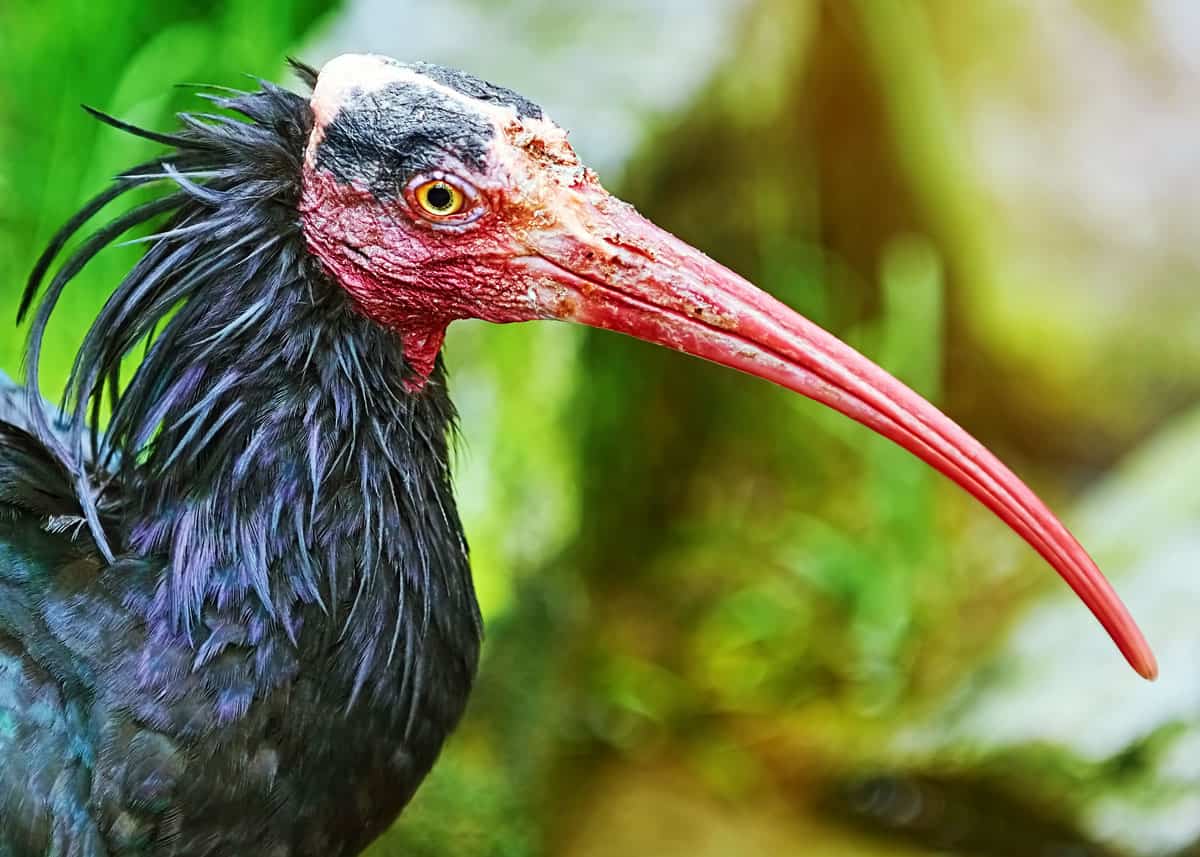
Table of Contents
11 of the Ugliest Birds in the World
Not all birds are created equal. There are beautiful birds, and then there are some… straight up ugly birds. Birds that have weird features like warty faces and long, dangly wattles.
Then, there are birds that just look plain scary. But, no matter how they look, birds fascinate us.
Before we get into it, I just want to say that even though these birds are “scary” and “ugly,” they all have a charm to them. They are still beautiful creatures that need to be protected. I have trouble identifying any creature as truly “ugly,” they all have a beauty that is unique. This post is meant solely for entertainment and to introduce you to some amazing creatures… so please don’t roast me :).
Want to know about some of the ugliest birds in the world? Check out the following top picks:
1. Helmeted hornbill
- Latin name: Rhinoplax vigil
- Unique ugly feature: Helmet-like casque on the bill
- Where they are found: Malay Peninsula, Sumatra, and Borneo
- Size: Length: 43 to 47 inches (110 to 120 cm); Weight: 6 to 6.8 pounds (2.6 to 3.1 kg)
- Diet: Fruits (especially figs) and insects
One look at the helmeted hornbill and you may readily accept the Punan myth that this bird guards the river that flows between life and death.
Should this hornbill’s appearance not startle you at first, its maniacal cackle will most certainly stop you in your tracks.
Two characteristics give the helmeted hornbill its intimidating appearance. The first is the most notable feature, the “casque,” which is the helmet-shaped structure above the bill.
Unlike other hornbills, this bird’s casque is solid rather than hollow, and combined with the skull, makes up for around 10% of the bird’s weight.
Not only is the casque shaped like headgear, but the male hornbill even uses it to joust and head-bang with other males when fighting over territory or figs, their favorite food.
The second scary feature is the bald, red throat that looks like it has been plucked of feathers.
If you can get past this hornbill’s fearsome features, you’ll notice that it also has black plumage with a white belly and legs as well as a black and white tail.
The female is similar to the male except that her throat patch is pale blue or green.
Found in the lowland rainforests of Borneo, Sumatra, and the Malay Peninsula, the helmeted hornbill is a critically endangered (very near extinction) species.
This is largely due to the many hunters out trying to kill the birds for their casques (made of solid keratin) that are sold for big bucks to carvers and handicraft makers.
A carved helmeted hornbill casque
Helmeted hornbills are monogamous birds which have a peculiar breeding habit.
Pairs work together to seal the female up inside a tree cavity with mud, fruit pulp, and feces, leaving a hole only large enough for the male to transfer regurgitated food to her as she incubates up to six eggs.
Once the chicks are ready to fledge, the adults break open the seal. This may seem like a strange habit, but it protects the chicks from predators.
2. Shoebill
- Latin name: Balaeniceps rex
- Unique ugly feature: Large, shoe-shaped beak
- Where they are found: Central-Eastern Africa
- Size: 43-55 inches (110 to 140 cm); Weight: 11 to 12 lbs (4.9 to 5.4 kg); Wingspan: 7.7 to 8.6 ft (230 to 260 cm)
- Diet: Lungfish, water snakes, baby crocodiles, lizards, rodents and waterfowl
Let’s be honest. You can’t expect a bird to win a beauty pageant when its face is attached to a giant bill resembling a clog shoe.
However, that doesn’t stop the shoebill from being one of the most popular birds on the must-see list for birdwatchers in Central-Eastern Africa.
They may be ugly… but they are also kind of adorable. I mean, look at that derpy face:

Standing tall (nearly 5 feet) on long, spindly legs, this prehistoric-looking stork is mostly slate-gray with big, round yellow eyes and a tuft of feathers on the back of its head.
But, the most striking feature is the massive bill that resembles a wooden clog shoe. Measuring about 4 inches wide and nearly 9 inches long, the shoebill’s clodhopper bill is a pale yellow with slashes of gray markings on it.
At the end of this razor-sharp beak is a hook-shaped nail that allows the shoebill to decapitate its prey, which is usually lungfish but also includes water snakes, baby crocodiles, small waterfowl, lizards and rodents.
Taller than most other birds with a wide wingspan and large feet, the shoebill looks like he could be a bully around other wildlife, but he is actually a quiet loner.
The shoebill prefers to stick to himself, standing like a statue in the freshwater swamps and waiting for his dinner to swim near enough for him to snatch up into his huge beak.
When the shoebill does decide to occasionally let loose with a little bill-clattering noise, it sounds like a machine gun.
During the breeding season, shoebills form temporary monogamous pairs and become territorial. Together, they build floating nests of about 3 feet (1 meter) in diameter with grass and other vegetation.
Both male and female share the incubation and rearing of two eggs.
3. Northern Bald Ibis
- Latin name: Geronticus eremita
- Unique ugly feature: Long, red and curved beak
- Where they are found: Morocco and Syria
- Size: Length: 28 to 31 inches (70 to 80 cm); Weight: 35 to 46 ounces (1.0 to 1.3 kg); Wingspan: 49 to 53 inches (125 to 135 cm)
- Diet: Lizards, beetles, small mammals, invertebrates and caterpillars
One look at the red, featherless head and long, curved beak of the northern bald ibis, and the first thing that comes to mind is the bird mask that plague doctors used to wear back in medieval times to ward off the bubonic plague.
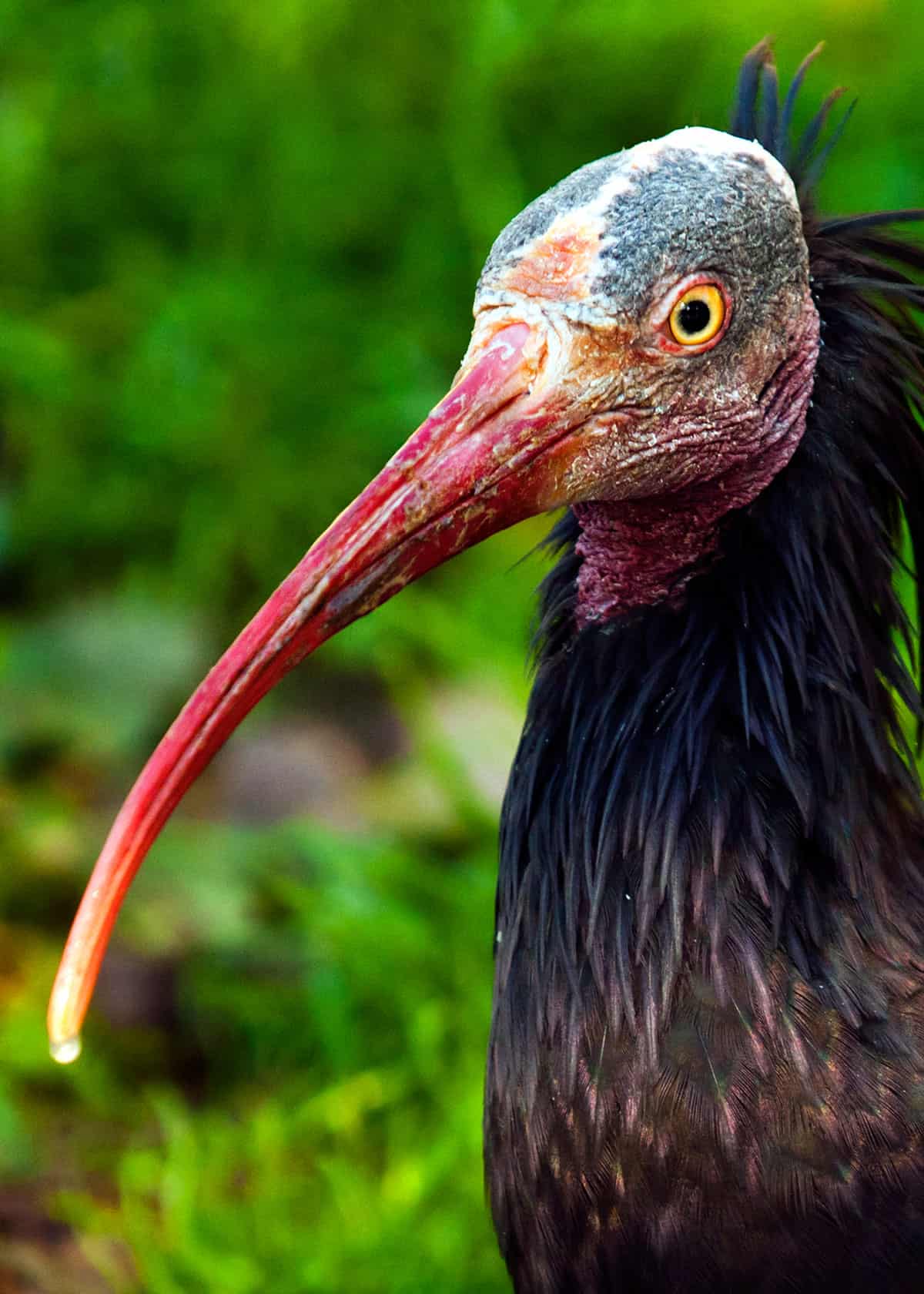
However, something other than the bubonic plague has devastated populations of this bird species over the last 300 years.
Experts aren’t sure, but they believe hunting, pesticides, and loss of habitat could be reasons why there are only small numbers of this ibis left in Morocco and Syria when this species was once widespread throughout Europe, northern Africa, and the Middle East.
Fortunately, there are reintroduction programs in progress to replenish the population.
In addition to this large bird’s striking head and beak, the rest of its body is glossy black with iridescent green, violet and bronze reflections.
Long, wispy feathers stick out behind the bird’s head like a Mohawk.

Unlike other ibis birds, which prefer wetlands, this species can be found in colonies on cliff tops or in dry deserts and fallow fields, foraging for the likes of scorpions, beetles, and lizards.
These ibises are socially monogamous, meaning that they may mate with others, but they are dedicated to raising the chicks of a nest they have built.
A male chooses the nest site and prepares it before waving a female over with his crest feathers and rumbling call. Once a male and female bond, they practice bowing and mutual preening before mating.
After the female lays two to four eggs, both parents will incubate them and feed the chicks.
4. King Vulture
- Latin name: Sarcoramphus papa
- Unique ugly feature: Fleshy wattle on the nose
- Where they are found: Central and South America
- Size: Height: 2 feet (0.61 m); Weight: 6 to 10 pounds (2.72 to 4.53 kg) ; Wingspan: 4 to 5 feet (1.21 to 1.52 m)
- Diet: Carrion
The king vulture is at first quite shocking to behold. One look at the unsightly wattle hanging from its wide nostrils, and you may think this scavenger bird has leftover viscera stuck on its face from its carrion dinner.
But, once you tear your eyes away from that, you may agree that this bird does have a certain charm about him.
I mean, how many other vultures do you see boasting a multicolored head? It’s kind of hard to decide if it’s beautiful or ugly!
Sure, his bald crown has short, bristle-like feathers, and his white eyes are red-ringed, but the rest of his head and face vary in vibrant colors of red, orange, yellow, green, and bluish-purple.
At the king vulture’s neck is a collar of grayish-black feathers. From there down, the body is white with a uniform band of black feathers lining the edge of the wings and tail.
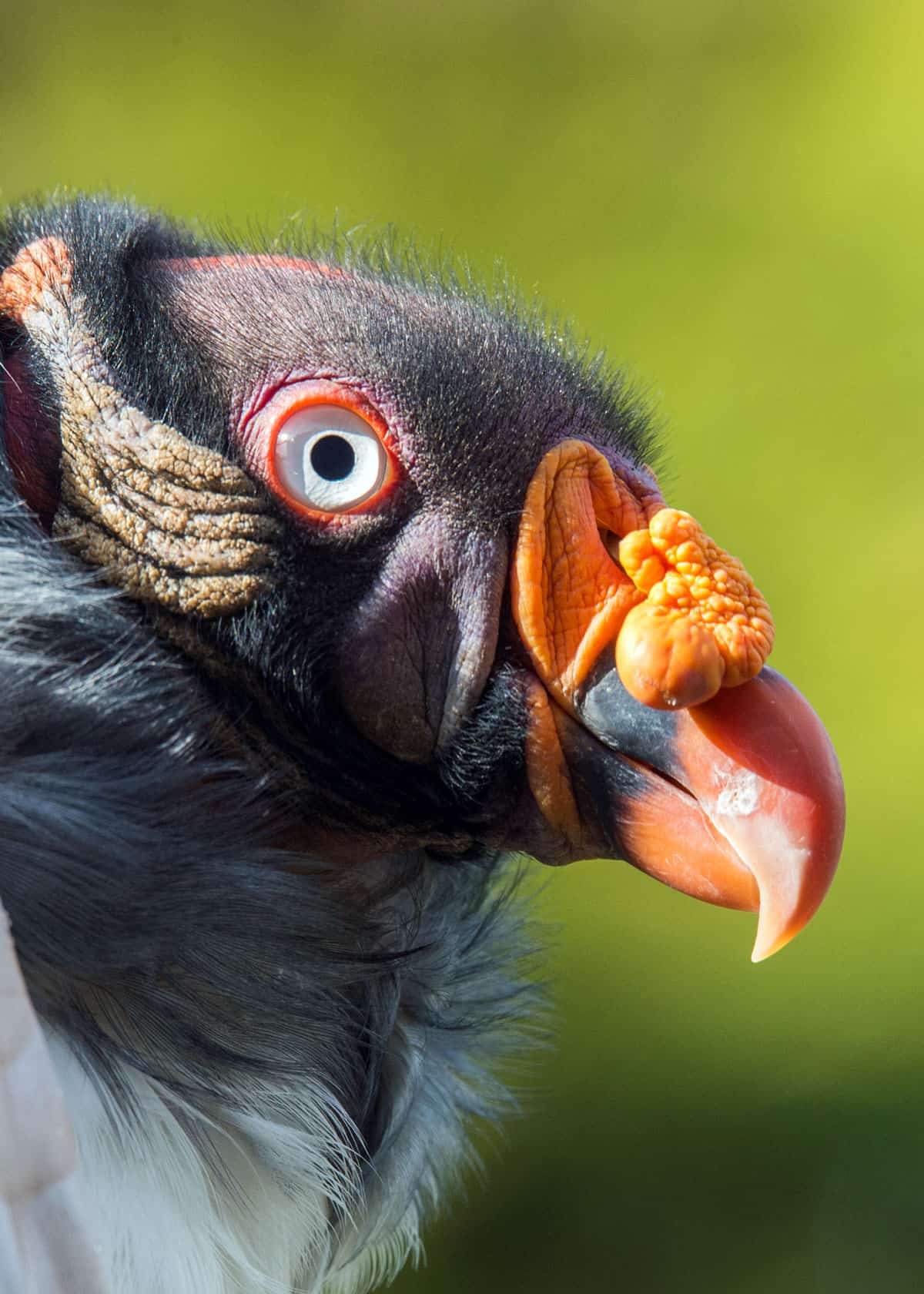
Found in the dense tropics of Central and South America, from Mexico all the way down to southern Argentina, the king vulture goes way back to ancient Mayan times when it was believed to be a “king” that transported messages from the gods to humans.
Although the king vulture is larger than other vultures with keen eyesight, thick, sharp claws, and a strong beak, it often waits for other scavenger species to do the hard work of tearing an animal hide open before feeding.
King vultures are monogamous with pairs mating for life. They make their nests on the ground in natural cavities such as hollow logs or tree stumps. Both parents share in the incubation of a solitary egg.
Love the king vulture? Check out some other colorful birds!
5. Turkey
- Latin name: Meleagris gallopavo
- Unique ugly feature: Red wattle, snood, and caruncles
- Where they are found: North America
- Size: Length: 30 to 49 inches (76 to 125 cm); Weight: 5 to 24 pounds (2.5 to 11 kg); Avg. Wingspan: 4.5 (1.37 m)
- Diet: Insects, seeds and the occasional lizard or frog
For a bird that was almost the national bird of the USA, the turkey certainly falls short a beauty crown.
I’ve seen small flocks of these ugly birds foraging in fields or running across a country road, and I always think they look like miniature dinosaurs.
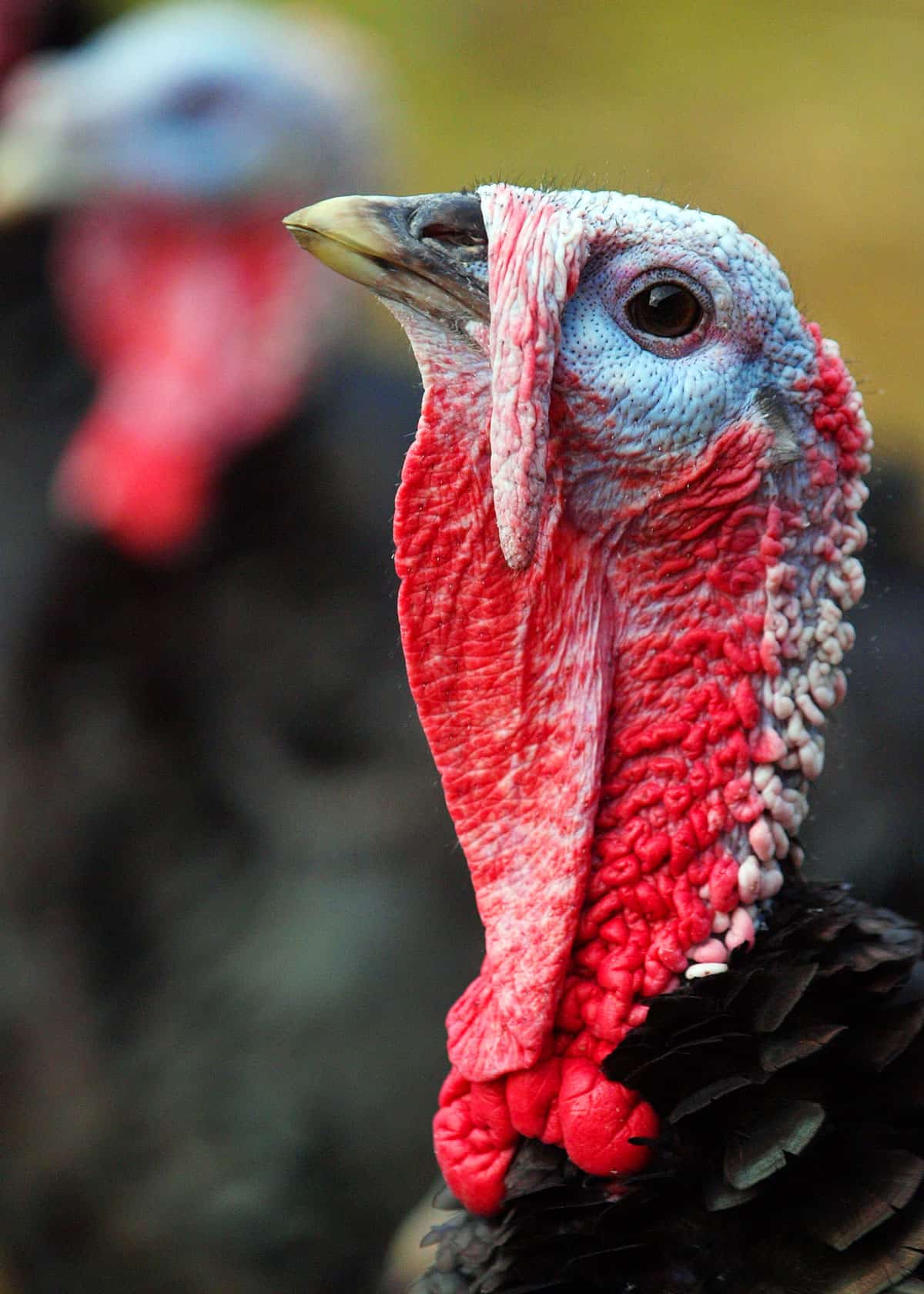
The male turkey, often called a gobbler, sports a large, round body of brownish-black plumage that is interspersed with iridescent colors of green, bronze and gold. That much about him is easy on the eyes, but his upper portion is another matter altogether.
His head, naked of feathers and covered with bumpy caruncles, is usually red but turns blue and white when the bird is excited.
A fleshy red snood grows from the forehead and dangles past the beak while a red wattle hangs from the throat. A tuft (beard) of dark feathers stick out from the male’s breast.
The female, or hen, is much smaller than the gobbler and is mostly brownish-black all over. She doesn’t (usually) have a beard but does feature a small snood and wattle.
The hen usually keeps her tail down, but the gobbler fans his tail out wide while also puffing up all his feathers when he is trying to impress the ladies or threaten other males away.
Native to North America, turkeys were first domesticated in Mexico long before the arrival of Christopher Columbus. Today, the turkey is grown in large numbers on commercial farms to provide for the centerpiece dish of the American Thanksgiving holiday.
Found in family colonies within the woodlands of southeastern and southwestern USA, the wild turkey is a game bird that is hunted for sport and food during the spring.
During breeding season, the polygamous male attracts a harem of hens by spreading his tail feathers, dropping his wings, and strutting about while gobbling. After mating, each hen will incubate between 8 and 15 eggs by herself.
Although on the heavy side, turkeys roost high in the trees. They can run up to 25 mph, and they can see ten times better than humans with a 360-degree field vision. So, it’s not likely that you will be able to sneak up on one too easily.
6. Capuchinbird
- Latin name: Perissocephalus tricolor
- Unique ugly feature: Hunched back and vulture head
- Where they are found: North and Eastern South America
- Size: Length: 15.75 inches (4 cm); Weight: 12 to 15 ounces (340 to 420 g);
- Diet: Fruits and insects‘
The capuchinbird looks like a small, hunchbacked vulture. While the body plumage is mostly a blend of brown, orange and chestnut colors, the wings and tail are dark brown or black.
The hunchbacked neck looks like it is about to swallow the naked, pale blue head and beak.

Found in the rainforests of northern and eastern South America (Venezuela, Colombia, Brazil, and the Guyanas), the capuchinbird makes an otherworldly sound to go along with its odd appearance.
Some people have described the call as the low mooing of a cow while others say it is more like the noise of a distant chainsaw.
Most of the time, these birds enjoy spending their time hanging out in the canopy, plucking fruits and insects.
When the breeding time comes around, the males gather in a lek where they display to the females by emitting their calls and puffing up their feathers.
The females, which look much like the males, will usually mate with the alpha male. Each female will then go on to build her nest of twigs and raise her single check alone.
7. Potoo
- Latin name: Nyctibius
- Unique ugly feature: Yellow, bulging eyes
- Where they are found: Central and South America
- Size: Length: 19 to 24 inches (48.26 to 60.96 cm): Weight: 12.69 to 22.91 ounces (360 to 650g); Avg. Wingspan: 29 inches (73.66 cm)
- Diet: Large flying insects (beetles, moths, grasshoppers)
Some of nature’s creatures are so ugly that they can’t help but look cute. The potoo is one such critter.
You probably won’t see or hear the potoo during daylight hours because it is nocturnal and likes to sleep all day.
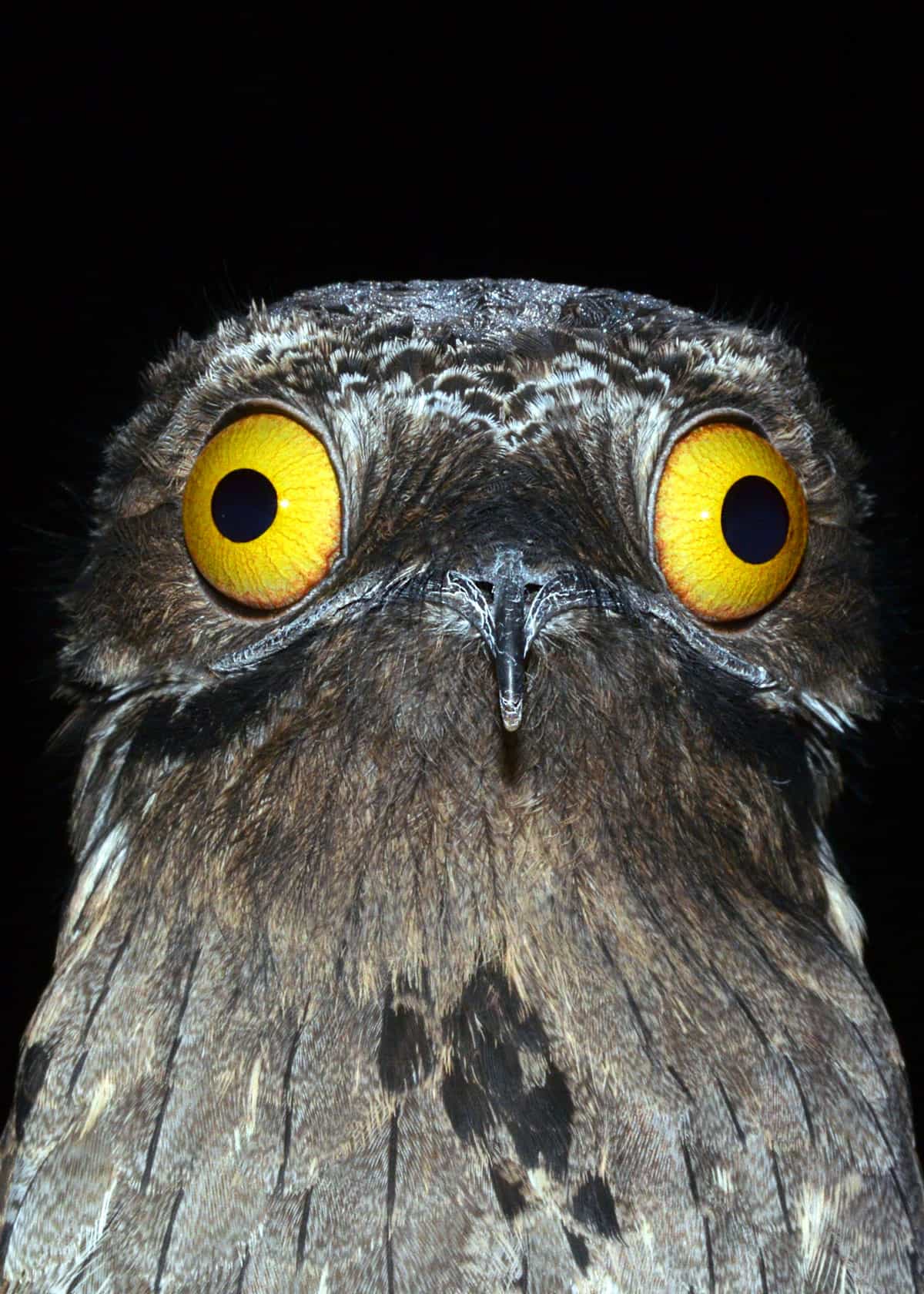
Even if you were to look right at the potoo as it sleeps upright on a tree branch, you may not see it because its plumage is a mottled green, gray and brown exactly like tree bark (both male and female). This way the potoo can stay hidden in broad daylight.
However, if you decide to go on a night safari in the rainforest of Central or South America, the potoo may just give you a shock with its bulging yellow eyes, long neck, small beak and large, gaping mouth that is used to catch fly-by insects.
If at first you don’t see the potoo, you may hear its eerie, haunting call in the night.
While usually solitary birds, potoos are monogamous breeders that share in the incubation and care of a single chick. Unlike many other birds, potoo pairs don’t actually build a nest but simply lay their egg in the crook of a branch or in the depression of a tree stump.
Read more about great potoos.
8. Muscovy duck
- Latin name: Cairina moschata
- Unique ugly feature: Red, warty face
- Where they are found: The Americas, New Zealand, Australia, Europe
- Size: Length: 30 inches (76 cm): Weight: (Male) 10 to 15 pounds (4.53 to 7 kg)
- Diet: Insects, fish, works and small reptiles
I have to be honest and admit that the first time I ever saw a muscovy duck, I felt a genuine concern that it had some kind of horrible disease growing on its head.
After learning more about this species, I now know it is a common trait of these ducks to have a warty face. Those red, bumpy things all over the duck’s face are called caruncles. The male also features a black or red knob near the bill.
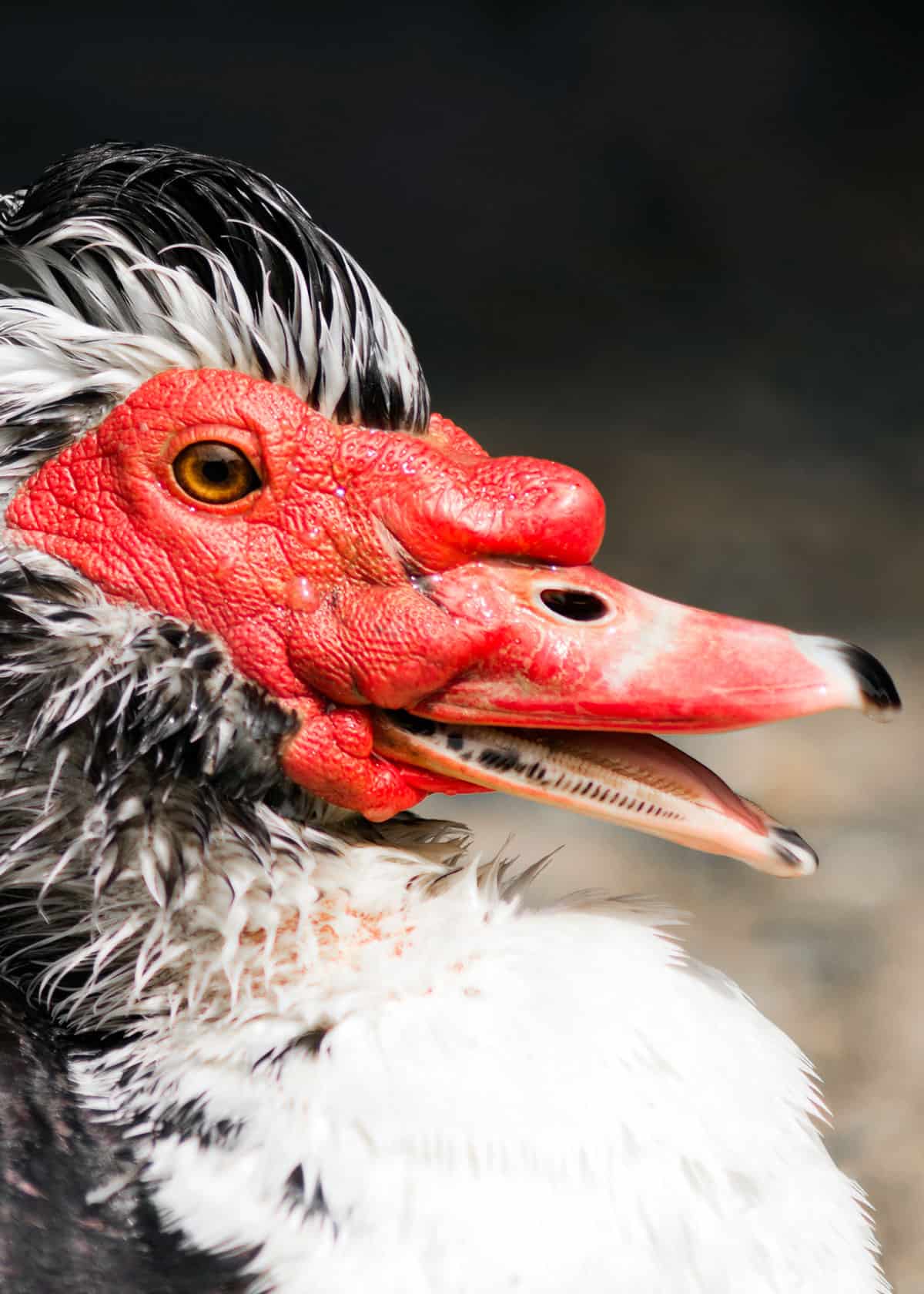
The body of the muscovy duck, for both sexes, is usually black and white, but the male’s black feathers are glossy and iridescent. Both sexes also have a short crest and black or yellow webbed feet.
Sometimes, domestic and wild muscovies differ in appearance. Some are mostly black or mostly white while others may be greenish-brown or even pale lavender.
Native to South America, muscovies have also established themselves in the USA, Canada, New Zealand, Australia, and Europe. They are also commonly bred as domestic birds in these same ranges. Muscovies are ducks, so naturally, they love congregating near water.
They can swim, but they don’t swim as well as other ducks because their oil glands are not as developed as other duck species. Although they are usually friendly with people, they are highly territorial and can be aggressive with other ducks.
Dominant males will sometimes fight with other males and force themselves on females. They talk to each other by wagging their tails and bobbing their heads up and down.
Muscovies breed up to three times a year, but they don’t form monogamous pairs. The males win a female over by fighting other males. Pairs can mate on land or in water. After mating, the female takes sole care of raising a clutch of 10 to 16 eggs.
9. Featherless Chickens
- Latin name: n/a … probably something like “Gallus gallus domesticus featherlessicus”
- Unique ugly feature: Nakedness
- Where they are found: Presumably in hot areas
- Size: (based on normal meat chickens) Weight: 4 lb (1.8 kg),
- Diet: special high protein feed to make them grow really fast
Ok, this one is all man’s fault. When I first saw these crazy chickens, I thought “seriously? this has to be one of the dumbest hoaxes ever!” Well, they are real. Featherless chickens are living, breathing… supper.
|
Their breeding was initiated by an Israeli geneticist as part of an experiment to breed chickens for hotter climates.
He says that the mutation occurred naturally in California over 50 years ago and the original chicken was kept and bred. In my opinion, this story seems to have some holes in it, but we’ll have to take his word for it. Here’s what he has to say:
Here’s the short story: genetically manipulated chickens – called broiler chickens – (kind of demoralizing… “and your name shall be dinner!“🙄) have a much higher heart rate than normal chickens because they have had their genes altered so they are constantly hungry.
This causes the chickens to overheat quicker than normal chickens; especially in warm climates. Featherless broilers are meant to solve that problem – keep the chickens cool… and embarrassed.
Being ‘naked’ is meant to make the chickens healthier and cooler. At least that’s what the researchers say when they are talking to the press.
They have also quietly slipped comments on what (in my opinion) is the real reason for this trick of science: saving money in processing plants because these chickens don’t need to be plucked. They also grow quicker than regular chickens, making more money – faster.
Some believe that these chickens will suffer more because they are more susceptible to sunburn, parasites, and mosquitoes.
Mating is also difficult or impossible because the males can’t flap their wings… they barely have wings. Temperature changes are also a big issue; these naked chickens do well in warm weather, but what if it suddenly got cold?
Other than their freakish appearance, they are meat chickens… normal, naked, genetically modified, fast-growing chickens. Little is widely known about these weird little freaks so far, but they really are basically naked broiler chickens. You can read about classic broiler chickens here.
Ok… Went a little “animal rights crazy” there… I’m sorry, I just think birds should have feathers.
You decide! Is this a humane alteration for the good of the bird, or just another money ploy where nature pays the price for our greed? Let us know in the comments!
10. Long-wattled Umbrellabird
- Latin name: Cephalopterus penduliger
- Unique ugly feature: Long, feathered wattle
- Where they are found: Columbia and Ecuador
- Size: 20 inches (51 cm); Weight: 11 to 20 ounces (320 to 570 g); Wingspan: 26 to 28 inches ( 66 to 71 cm)
- Diet: Lizards, insects, and fruit (especially palm-nuts)
This jet-black cotinga might be described as beautiful if it weren’t for the extremely long wattle dangling from the male’s throat. Somehow, that bizarre appendage makes it look less appealing to human eyes even if it does send all the female umbrellabirds to fluttering with excitement.
Although the female doesn’t have much of a wattle, she does sport the same poofy crest from which the species gets the name “umbrellabird.”
Found in a long stretch of lowland forests from Colombia to southwestern Ecuador, the long-wattled umbrellabird serves an important role in seed dispersal due to its large consumption of fruits. (Palm nuts are said to be their favorite.)
Males are polygamous and spend much of their time at leks, displaying for female attention by swinging their extended wattles and making grunting noises.
Each female choose her favorite male, and after mating, goes on to build her nest and raise a single chick.
11. Marabou Stork
- Latin name: Leptoptilos crumenifer
- Unique ugly feature: Rotting-like head
- Where they are found: Sub-Saharan Africa
- Size: 5 feet (1.52 m); Weight: 9.9 to 18 pounds (4.49 to 8.16 kg); Wingspan: 7.4 to 9.4 feet (2.25 to 2.86 m)
- Diet: Carrion
If there is an ugly bird contest out there somewhere, the marabou stork should take the winning crown.
One of the tallest birds in the world, this large stork of sub-Saharan Africa is the epitome for the phrase “you are what you eat” because his face and head look every bit as rotten and decayed as the carrion flesh that he eats.
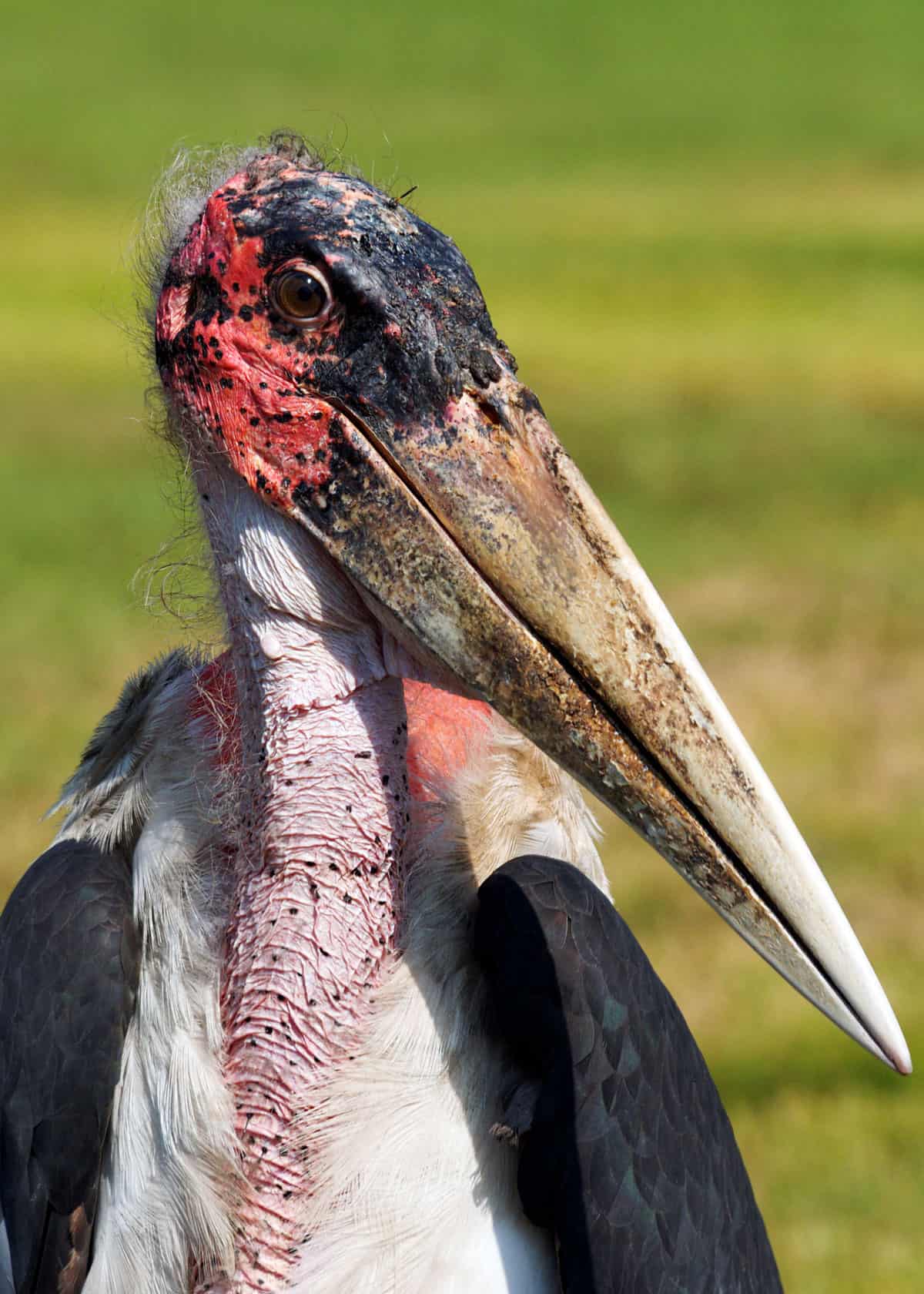
From his throat hangs a long, pink and wrinkled wattle that borders on obscene. His white underbelly, black cloak-like wings, long skinny legs, and hunched-over posture make him look like the butler at death’s door.
As if his scary looks aren’t bad enough, the marabou stork also practices what we humans might consider some nasty behaviors.
Not only does he eat dead animal carcasses and human waste, but he also deliberately poops on his legs, and he loves hanging out at landfills, trash dumpsters, and slaughterhouses.
However, I can’t be too hard on the marabou stork for all his unbecoming traits because they really do serve a purpose. As a garbage and carrion eater, this stork helps keeps the environment clean so that diseases don’t breed.
As for defecating on his own legs and feet, this stork does this as a cooling mechanism to regulate his body temperature.
Marabou storks are monogamous birds that mate for life. The males attract females by dancing, bill-clattering, and inflating their throat pouches.
They make their nests in trees and bushes. After the female lays three to five eggs, both parents will equally care for the young.
Imperfection is… Beauty?
As the popular saying goes, “Beauty is in the eye of the beholder.” I suppose that goes for ugliness as well.
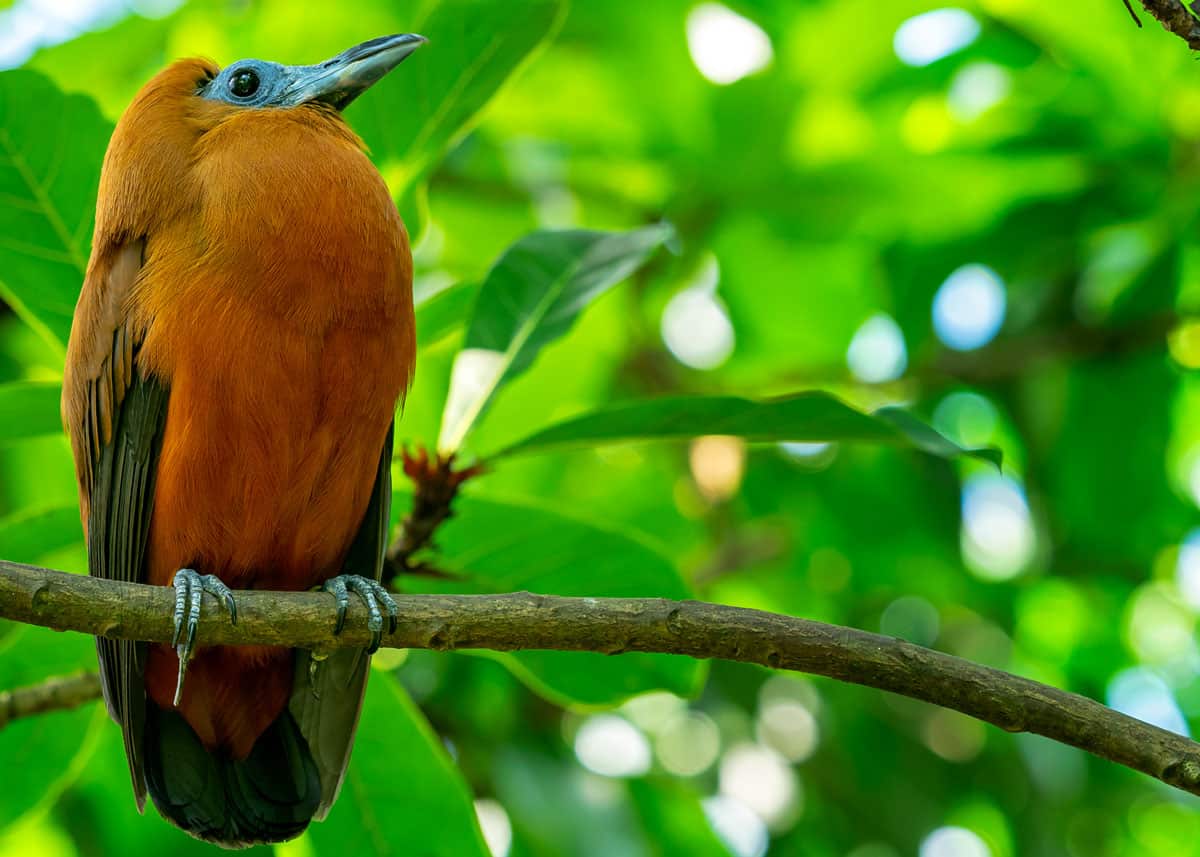
What bird you think is the ugliest? Did we miss your favorite? Let us know in the comments, and we might include your pick!
Drew Haines is an animal enthusiast and travel writer. She loves to share her passion through her writing.
She graduated high school at sixteen and started her own business, Everywhere Wild Media. And she runs Everywhere Wild and JustBirding. She also guest blogs on Storyteller.Travel
She lived in Ecuador for 6 years and explored the Galapagos Islands. Currently based in N.S., Canada.

Adri
Tuesday 7th of May 2019
These birds are so ugly they are so cute
Adri
Tuesday 7th of May 2019
I think there should be a group and they g out and look for some really ugly bired. To me they are so ugly the are cute